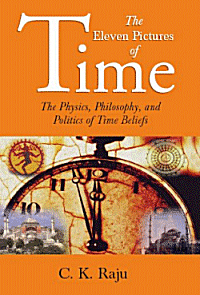The Eleven Pictures of Time

వ్యాసకర్త: Halley
*********
ఈ పరిచయం సి కె రాజు గారు రాసిన “The Eleven Pictures of Time: The Physics, Philosophy and Politics of Time Beliefs” అనే పుస్తకం గురించి. సి కె రాజు గారి గురించి ఆయన వికీ పేజీలో చదవచ్చు. ఈ పుస్తకం “కాలం” గురించి, కాలం గురించిన మన ఆలోచనలు మన జీవన విధానాన్ని ఎలా ప్రభావితం చేసాయి, చేస్తున్నాయి, చేస్తాయి అని చెప్పే పుస్తకం. నిజానికి ఇలాంటి పుస్తకం రాయటం పెద్ద సాహసమే అనుకోవచ్చు. బాగా scholarly పుస్తకం ఇది. కొన్ని కొన్ని పేజీలు ఎంత చదివినా అసలు ఎక్కలేదు నా మట్టి బుర్రకు. అయితే ఇలాంటి పుస్తకం మన భారతీయ శాస్త్రవేత్త ఒకాయన రాసాడు అన్న విషయము పంచుకొవాలనీ (ఈ పుస్తకం “a sort of rejoinder to books like Stephen Hawking’s A Brief History of Time”, అని అన్నారు పరిచయంలో), ఈ “కాలం” కబుర్లు గురించి తెలుగులో ఎవరన్నా ఏమన్నా రాసారో నాకు తెలిదు కాబట్టి తెలుగు పాఠకులతో ఈ విశేషాలు పంచుకోవాలనీ అనిపించి రాస్తున్న పరిచయం ఇది.
ఇది కొంచెం పెద్ద పరిచయం. ఏదో పెర్సనల్ బ్లాగులో రాసుకోవాల్సినది ఏమో. అయినప్పటికీ సగమో పావో ఎవరో ఒకరు ఈ పరిచయం చదివి తిరిగి సి కె రాజు గారి పుస్తకం తెరుస్తారేమో అన్న ఆశతో పెద్దదైనా సరే ఈ పరిచయం రాసే సాహసం చేస్తున్నాను. ఈ పుస్తకం గురంచి ఒకటి రెండు పేరాలలో చెప్పటం కుదరదు అని నా భావన.
పుస్తకం మొదట్లో ప్రోక్లుస్ అని ఒక గ్రీకు తత్త్వవేత్త మరియు గణిత శాస్త్రవేత్త గురించి చెబుతూ “For Proclus, mathematics was not a ‘secular’ activity, but the key means of propagating his fundamental religious beliefs about life after death” అని అన్నారు. పుస్తకం లో ఇది ఒక ప్రధాన అంశం. ఈ రచయిత ఈ సబ్జెక్టు మీద (science and theology) మరికొన్ని పుస్తకాలు కూడా రాసారు. కొన్ని కొన్ని చోట్ల “అబ్బో! మ్యాథ్సు లో ఇంత theology ఉందా” అని అనుకున్నాను నేను. ఉదాహరణకి Mathematics అన్న పదం “Mathesis” నుంచి పుట్టింది అంట. ఆ పదానికి అప్పటి అర్థం “recollection of knowledge that the soul acquired in its previous lives” అని అట! మరొక ఉదాహరణగా ఇది చదవండి “The mathematical symbol ∞ (infinity) comes from the ‘circle of infinity’: a serpent symbolising cosmic recurrence by swallowing its own tail”. ఏదో సరదాగా వాడేస్తూ ఉంటాము కానీ “∞” వెనక పెద్ద దుమారమే రేగింది అట అప్పట్లో. అంటే ఈ సింబల్ ని ఒప్పుకుంటే మరి పునర్జన్మలనీ అనంతమైన కాలాన్ని అత్మలనీ ఒప్పుకోవాల్సి వచ్చి సృష్టి అనాది అనీ ఒప్పుకోవాల్సి వచ్చి అది creationism కి అడ్డు వచ్చి అలా రక రకాల గొడవలు అయ్యాయి అంట అప్పట్లో. ఇది 6th century నాటి మాట. ఇది మొట్ట మొదటి “creationist controversy” అట. “∞” సింబల్ వెనుక ఇంత పెద్ద కథ ఉంది అనమాట!
నాకు క్రైస్తవం గురించి పెద్ద పరిజ్ఞానం లేదు, ఏదో మిడిమిడి జ్ఞానం తప్పించి. అయితే ప్రధానంగా క్రైస్తవుల నమ్మకాలలో మనిషి చనిపోయాక ఫలానా ఒక కాలంలో క్రీస్తు (లేదా దేవుడు) మళ్ళీ వచ్చి, పాప పుణ్యాలను బేరీజు వేసి స్వర్గానికో నరకానికో పంపిస్తాడని ఒక నమ్మకం వారిలో ఉంది అని మాత్రం తెల్సు. అందుకనే ఎవరన్నా చనిపోతే క్రైస్తవులు “rest in peace” అని అంటారు. అంటే ప్రభువు తిరిగి వచ్చి నిన్ను మేలుకొలిపే దాకా నీ శరీరంలో నువ్వు అలానే ఉండు అని. అయితే క్రైస్తవం కూడా ఇంత సింపుల్ మతం ఏమి కాదని ఈ పుస్తకం చదివాక తెల్సుకున్నాను. ఇంచు మించు ఐదవ శతాబ్దంలో క్రైస్తవ మత పెద్దలకు రాజ్యకాంక్ష పెరగనంత వరకు వేరే రకం క్రైస్తవం ఉన్నట్టుగా ఉంది మరి.
ఒరిగెన్ అని ఒక పెద్దాయన అప్పట్లో అంటే ఒకటి రెండవ శతాబ్దం మధ్యలో అప్పటి ప్రజల దృష్టిలో అప్పటి చర్చి దృష్టిలో గొప్ప మత గురువు అంట. అయన సనాతన ధర్మంలోని కర్మ సంస్కార సిద్ధాంతమునకు మల్లే “Every soul… comes into this world strengthened by the victories or weakened by the defeats of its previous life. Its place in the world… is determined by its previous merits or demerits. Its work in this world determines its place in the world which is to follow this” అని నమ్మేవాడట. అయితే ఇందాక చెప్పినట్టు చర్చి stateకు దగ్గర అయ్యే కొద్దీ ఇటువంటి సిద్ధాంతాలను pagan నమ్మకాలు అని ముద్ర వేసి కాలరాసారు అంట అప్పట్లో. బాగా complex విషయం ఐనప్పటికిని నాకు అర్థం అయ్యింది ఇదీ ఈ Origen విషయం లో. ఎవరి జీవితాలను వారి కర్మలే వారి సంస్కారాలే నిర్దేశిస్తాయి అన్నప్పుడు ఇక చర్చి వారి అజమాయిషీ ఏముంటుంది ఇది మంచి ఇది చెడు అని చెప్పటానికి? అందుకని అప్పట్లో కాలం గురించిన ఆలోచనలు సమూలంగానే మార్చేసారట. కాలస్వరూప విషయంలో ఈ మార్పు క్రీస్తు చనిపోయిన కొన్ని వందల ఏళ్ళకు వచ్చింది అంట. ఇదంతా ముదిరి పాకన పడి చివరకి Augustine ఇలా తీర్మనించాడట. రచయిత మాటలలో చెప్పాలంటే “Augustine’s efforts produced a new picture of the world. Instead of quasi-cyclic time, one now had apocalyptic time. Instead of the series of lives with quasi-cyclic time, one now had just two—one life in this world, and one life in the world that was to follow. The short life in this world was a unique opportunity. Though all would be restored in the flesh on the day of judgment, only the select few went to heaven: the rest went to hell, for ever, without any possibility of a transfer from one place to the other”. మిగిలిన విషయాలన్నీ పక్కన పెడితే early christianity గురించి నాలో కుతూహలం రేకెత్తించింది ఈ పుస్తకం.
ఇక మరో చోట న్యూటన్ గురించి కొన్ని కొత్త విషయాలు తెలిపారు. మనకి ఇస్కూళ్ళలో చెప్పే విషయాలు కావు ఇవి. అయన పెద్ద శాస్త్రవేత్త అనీ యాపిల్ చెట్టు కింద కూర్చున్నాడనీ ఏదో చెప్పేస్తారు అంతే. కానీ “more than 50 per cent of what Newton physically wrote was on theology” అని చెప్పే సాహసం చేస్తారా? సి కె రాజు గారు చేసారు. అందుకనే పుస్తకంలో ఈ భాగం నాకు తెగ నచ్చింది. అంటే Newton చెప్పిన విషయాలని మనం “Theories” ఎందుకు పరిగణించము “Laws” గా ఎందుకు పరిగణిస్తాము అని కొన్ని విశ్లేషణలు చేసారు. ఈ విషయమే చెబుతూ “Newton referred to the ‘laws’ of physics because he thought the laws of God had been revealed to him. In addition to these laws, he thought that God made occasional providential interventions” అని అన్నారు. న్యూటన్ లాస్ అని హాయిగా వాడేస్తూ ఉంటాం కానీ ఆయన “లా” అన్న పదం అది దేవుడి న్యాయం అన్న ఉద్దేశంతో వాడాడా అని తెల్సుకుని ఆశ్చర్యపోయాను. న్యూటన్ కూడా కాలం గురించి ఇందాక చెప్పిన Augustine కు మల్లేనే అనుకున్నాడు అట. దీనినే apocalyptic టైం అని అంటారట.
ఇక మధ్యలో ఇంచుమించు ఒక వంద పేజీలు ఐంస్టీన్ గురించీ పేరు తెలియని సైంటిస్టుల గురించీ నోరు తిరగని ఏవో సిద్ధాంతాల గురించీ చాలా లోతైన చర్చలు ఉన్నాయి. అయితే నాకు ఎమన్నా అర్థమైనట్టుగా అనిపిస్తే కదా వాటి గురించి నేను ఏదైనా చెప్పటానికి! సగం పుస్తకం ఐపోయాక మళ్లీ పామరుల భాషలో “How does a changed picture of time affect everyday life?” అని అన్నారు రచయిత. ఇక్కడి నుంచి మళ్లీ బాగా అర్థమయ్యింది నాకు ఈ పుస్తకం.
మన ప్రస్తుత కాలం “Time = Money” కాలం అని అన్నారు. ఈ కాలం యొక్క కాలం కబుర్లు చెబుతూ లోకాయతులు (చార్వాకులు) కాలం గురించి ఏమనుకున్నారో, బౌద్ధులు , జైనులు , ముస్లింలు కాలం గురించి ఏమనుకున్నారో అవి వారి వారి జీవన విధానాలను ఎలా ప్రభావితం చేసిందో ఈ అంకం లో చెప్పుకొచ్చారు. ఈ Time = Money గురించి చెబుతూ గడియారం మన జీవితాలని ఎలా మార్చిందో చెప్పారు . ఈ విషయం పై రచయిత మాటల్లోనే-
“To be able to maximise profit, the capitalist needed to control the production process. To control the production process, it was necessary for the capitalist to be able to vary the rate of production— to increase it when desired, and decrease it when needed. This was not possible if people were not ready to work hard now in return for a promise of future consumption. This was behaviour that had to be taught. In pre-capitalist societies it was not possible for the capitalist to double the production by doubling the wages. Therefore capitalism, to succeed, had to change human nature. Unlike slaves, the capitalist enterprise did not control people using the whip or the sword. It controlled them using and propagating the equation time=money. The common wrist watch is hence a symbolic shackle to industrial capitalism.”
గడియారం కాలం వెనకాల ఇంత పెద్ద “plot” ఉందనమాట! ఈ విషయం గురించే మరి కొంత:
“Thus, the time=money of industrial capitalism involves two key ideas, each consisting of a physical belief and an associated norm. The first physical belief is that this life is the only one that there is. The associated norm is that the period from birth to death is the only thing that one need think about— one ought not to think about the long term or about life or anything else after death. The second norm is that this life from birth to death ought to be so planned as to earn as much money as possible. The associated physical belief is that life can be so planned, since the future can be rationally calculated”
ఇలానే మరొకటి:
“Globalising culture suits industrial capitalism, which seeks to establish mechanical uniformity; but the culture that is globalised must suit it. The suitability depends upon the underlying time beliefs. Many recent writings on time have stressed that time beliefs in Western culture harmonise with time beliefs in industrial capitalism. What is the origin of this harmony? Why are time beliefs in industrial capitalism discordant with time beliefs in other traditions?”
కాలం తాలూకా నమ్మకాల గురించి నన్ను బాగా ఆలోచింపజేసాయి ఈ వాక్యాలు. ఒక్కో ప్రాంతం లో కాలం గురించి ఒక్కో భావన ఉండటం industrial capitalism ని ఎన్ని కష్టాలకి గురి చేస్తుందో ఆలోచించగా ఆలోచించగా అర్థం అయ్యింది.
ఇక మెల్లగా మన విషయాల్లోకి వచ్చారు. ఇక్కడి నుంచి పుస్తకం అసలు ఇంకా ఊపు అందుకుంటుంది. ఇందాక చెప్పినట్టు Quasi-cyclic time అని ఒక మాట వాడారు రచయిత మన కర్మలు – జన్మలు తాలూకా కాల స్వరూపాన్ని వివరిస్తూ. దీని గురించి రచయిత మాటల్లో :
“Suppose that time is quasi-cyclic; or suppose that you are convinced that the world is really like that. What difference would it make to your everyday life? What are the consequences for ethics (or values) of the belief in life a long time after death?
Deliverance (mokìa) is the ‘natural’ value associated with this picture of time. If this picture of time is taken seriously, the ‘natural’ inclination is to avoid the pain of rebirth and re-death. This is the message of the symbols of rebirth from across the world. This is the message that sweeps across the Upaniìads: deliverance is possible by breaking all worldly relations through the union (yoga) of âtman with Brhman. Breaking all worldly relations broke also any causal relation between an action and its fruit: deliverance transcended mundane ideas of good and bad, it transcended morality.
For those not prepared for this ‘highest of all achievements’, the appropriate thing was to be ‘good’ in preparation for this ultimate objective. One reaped the reward for one’s good deeds, and suffered for one’s bad deeds, in the present world or in future worlds. This reward and suffering were not distributed by a God sitting in judgment; they were automatic consequences of causality”
అయితే కాలం గురించిన ఈ నమ్మకం నుంచి వచ్చిన వర్ణ వ్యవస్థ గురించీ , దాని తాలూకా సాధక బాధకాల గురించీ కొంత చెప్పాక. దీనిని ప్రశ్నిస్తూ వచ్చిన చార్వాకులు/లోకాయతుల నమ్మకాల దగ్గరికి వచ్చారు. ఈ Quasi-cyclic కాలాన్ని వారు ఒప్పుకోలేదనీ అదే పంథాలో ఆత్మని, దైవాన్ని అన్నిటినీ వద్దన్న విధానం గురించీ చెప్పుకొచ్చారు. అయితే ఇదేమి కొత్త విషయం కాదనుకోండి! కానీ రచయిత analysis ఇంకొక అడుగు ముందుకి వెళ్తుంది ఈ విషయంలో. అది కొత్తగా అనిపించింది నాకు. లోకాయతుల నమ్మకాన్ని “Time=Money” పోలుస్తూ అయన ఇలా అన్నారు.
The Lokâyata was undoubtedly a materialist and this-worldly philosophy. Nevertheless, it would have rejected also the time=money of industrial capitalism. According to the opponents, for the Lokâyata only today mattered: “while life remains, let a man live happily; let him feed on ghee even though he runs in debt!” This is an attitude incompatible with the doctrine of maximising discounted deferred consumption.
అయితే ఈ లోకయతుల నమ్మకాల ప్రకారం కనుక కాలాన్ని మార్చి ఊహించుకొని దానికి అనుగుణంగా విలువలని కూడా మార్చుకుంటే సమాజంలో అల్లకల్లోలమే మిగులుతుంది అని అప్పట్లో కొందరు నైయాయికులు అనేవారట. దానికి ఉదాహరణగా ఒక మాట రాసారు :
If this doctrine is consistently applied and people begin to disbelieve all that they do not perceive at any particular time, then all our practical life will be seriously disturbed and upset. For example, it was argued, each time the husband went out of the house, the wife must become a widow, for she could no longer directly perceive her husband.
ఇది ఇలా ఉంచితే, బౌద్ధులు కాలం గురించి చేసిన ఆలోచనలు ఏమిటి? అవి వారి జీవన విధానాన్ని ఎలా ప్రభావితం చేసాయి? అని చెప్పుకొస్తూ బౌద్ధులు కాల ప్రవాహాన్నీ జన్మలనీ కర్మలనీ కాదనక పోయినా ఆత్మని కాదనటం వలన వారి ఉద్దేశంలో కాలం యొక్క స్వరూపం మారిందనీ అది వారి జీవన విధానాన్ని ఎంతో ప్రభావితం చేసిందనీ చెప్పారు. ఇదే విషయం చెప్తూ ఈ కాలం గురించిన ఆలోచన పాప పుణ్య విభజనని ఎలా ప్రభావితం చేసిందో చెబుతూ ఇలా అన్నారు.
Thus, unlike Augustine who denied quasi-cyclic time but accepted its chief consequence—the existence of the soul—the Buddha did not deny quasi-cyclic time, as such, but rejected its chief consequence—the existence of the soul. For, while change is manifest, the existence of an underlying changeless entity—the soul—is neither manifest, nor can it be readily inferred. The Buddhist denial of the soul shatters the basis of values in Augustine’s doctrine of sin. Augustine wanted to classify people as good or bad, through his notion of heaven and hell. The Buddha classified not people but only actions as good or bad.
ఇక బౌద్ధానికి క్యాపిటలిజం కి లోకయతానికి ఉన్న తేడా గురించి చెబుతూ ఇలా అన్నారు-
Buddhist values certainly differ also from values in industrial capitalism. In an industrial-capitalist society, an action is regarded as good if it helps one to increase the present value of lifetime earnings or consumption. The Buddha rejected this idea of material acquisition at the very beginning of his search for knowledge, having abandoned a princely life, which would have better enabled him to pursue the Lokâyata recommendation of material comfort, or the industrial-capitalist norm of maximising acquisition and consumption. The Buddha did not accept that increasing consumption would increase one’s happiness; he thought the right aim was freedom from suffering, and the right way to this was through compassion
ఆ విధంగా కాలం గురించెడి ఆలోచనలకి బుద్ధుడు చేసిన మార్పులు ఆ మార్పుల ప్రభావం వలన జీవన విధానంలో “బౌద్ధ సంఘాలు” తెచ్చిన మార్పులు వగైరాల గురించి సుదీర్ఘంగా చర్చించారు.
ఇక ఇలానే ముస్లింలు కాలం గురించి చేసిన ఊహల గురించీ అవి వారిని ప్రభావితం చేసిన విధానం గురించి చెప్పుకొచ్చారు. అయితే నాకు ఇస్లాం గురించి కూడా తెల్సింది తక్కువే. ఈ పుస్తకం పుణ్యమా అని అప్పటి ఇస్లాం లో కూడా “Mu‘tazilah school of rationalists” అని ఒకరు ఉండేవారని తెల్సుకున్నాను. ఇస్లాం లో కాలం గురించి చెబుతూ ఇలా అన్నారు: “we see three traditions about time in Islam. The first is that of the Philosophers, the second is that of orthodoxy, and the third is that of Sufi-s. The Philosophers propagated quasi-cyclic time, orthodoxy propagated ontically broken time, and the Sufi-s tried to combine both”
అయితే ఈ పోను పోను ఈ రక రకాల కాలం గురించి ముస్లింలలో వాదోపవాదాలు అయ్యాక అల్ ఘజాలి అని ఒక తత్త్వవేత్త వాదనా పటిమ దెబ్బకి ఇస్లాం లో ప్రధానంగా ఈ ontically broken time అన్నది పాతుకు పోయింది అంట. దీని గురించి అనగా “ontically broken time” గురించి వివరిస్తూ ఇలా అన్నారు:
“Allah created the world afresh each instant, but in a habitual sequence not in a causally fixed sequence. Anyone who seriously believes this view of time cannot but surrender to the will of Allah”
ఈ తరహా కాలంని నమ్మటం వలన జీవన విధానం లో వచ్చే మార్పు గురించి ఇలా అన్నారు:
“With ontically broken time, there was no definite connection between one instant and the next; anything could happen at the next instant, so the world could not be rationally understood. Hence, knowledge was devalued, and ethical practice was venerated”
“Since ontically broken time required surrender to God, and since the rejection of logic required also the suspension of one’s critical faculties, those more closely linked to the state used this to privilege hierarchy and reinforce authority.”
ఈ రక రకాల కాలాల గురించి మాట్లాడాక రచయిత తిరిగి నేటి “Time = Money” కాలానికి వచ్చేసి ఇలా అంటారు. ఈ అబూ యాజిద్ పిట్ట కథ నాకు తెగ నచ్చింది. మార్కెటింగ్ లో ఎంబీయే చేసిన నాకు అప్పట్లో ఇట్లాంటి ప్రశ్నలు వచ్చేవి. “కొనండి కొనండి ఇంకా కొనండి” అని చెప్పే సంస్కృతికీ “త్యజించండి త్యజించండి ఇంకా త్యజించండి” అని చెప్పే సంస్కృతికి చాలానే తేడా ఉంది మరి. అయితే ఈ తేడాలన్నిటికీ ఒక ప్రధాన కారణం ఆయా ప్రాంత ప్రజలు కాలం గురించి చేసిన ఆలోచనలలో ఉండే తేడా అని ఈ పుస్తకం ద్వారా తెల్సుకున్నాను.
“The earlier time-beliefs, and related values, are incompatible with the time = money of industrial capitalism. Contrast, for instance, the value of accumulation in industrial capitalism with the case of Abu Yazîd, who was disturbed one evening. He asked his disciples to see if there was anything ‘valuable’ in his house. Because of the extreme simplicity of his lifestyle, nothing was found except half-a-bunch of grapes. Abu Yazîd immediately asked his disciples to give them away, saying: ‘My house is not a fruiterer’s shop’.Only after that did he recover his composure. These traditional values are simply not possible values in an industrial capitalist society. Any attempt to restore those values must first reorganise society”
“At the foundational level of time beliefs, there is complete harmony between Western Christianity and industrial capitalism. Altering that time belief by, e.g., accepting quasi-cyclic time would rock the entire industrial capitalist lifestyle and the religious metaphysic suited to it—Keynesian economics does not go well with the belief that in the long run one returns to life”
ఈ చివరాఖరున అన్న మాట నాకు తెగ నచ్చింది. సాధారణంగా ఆర్థిక శాస్త్రం బేసిక్ కోర్సు చదివిన వాళ్ళకి కీన్స్ అన్న “in the long run, we are all dead.” అన్న వాక్యం గుర్తే ఉంటుంది. అయితే ఆ మాటకి కాలం గురించిన నమ్మకానికీ లంకె పెట్టిన విధానం నాకు నచ్చింది.
(మిగితా వ్యాసం రెండో పేజీలో!)




Santosh
Thoroughly enjoyed this piece . But I felt the author was quite polite in projecting it from time standpoint instead of religion because time / death is the primary question every religion tries to answer and most of any religion’s content is derived from how it answers this question.
There is more than one aspect that made this book interesting to me. (1) Science and theology connection (2) How religious beliefs have effected the societies in past / present. Looks like the authored explained the consequences pretty clearly. (3) His model of order creation as a solution is easy to comprehend. But it is not easy to let everyone understand this standpoint and encourage them to follow the same. Everyone does not possess the same capacity for reason. How you would impart this model in the modern world is still a question. Also, if achieved, how you would take it forward is another question. Reading the book would probably help me understand his model more clearly. Thank you!
guest-1
Thanks for introducing this book. I’m enjoting it as I write this comment.
Coming to the infinity-serpent, that is called Ouroboros.